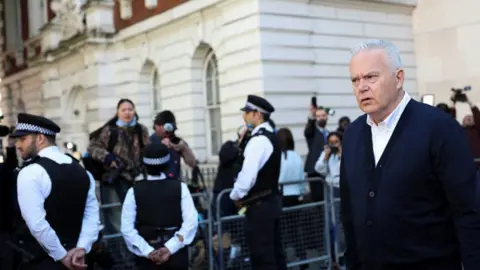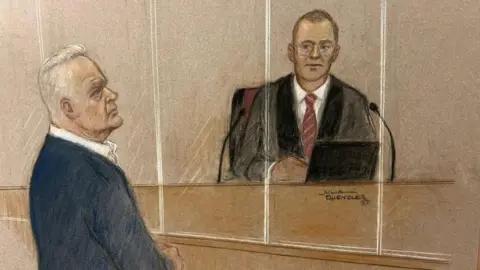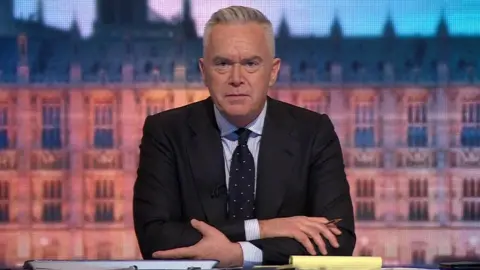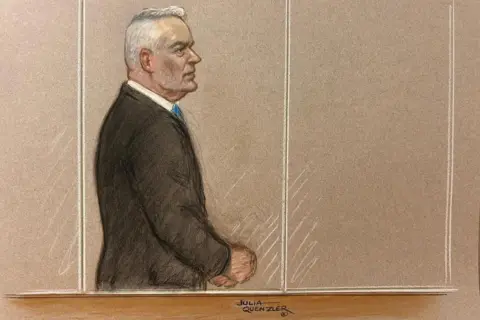 Metropolitan Police
Metropolitan PoliceDisgraced BBC News presenter Huw Edwards has been given a six-month prison sentence, suspended for two years, after he admitted charges of making indecent images of children.
The court heard that among a number of WhatsApp exchanges with a man since convicted of paedophilia, Edwards was offered “naughty” images of somebody described as “yng (sic)”, to which he replied “go on”.
He will be placed on the sex offenders’ register for seven years.
In July, the former newsreader admitted having 41 images, which were sent to him on WhatsApp – including some showing a victim aged between seven and nine.
During his sentencing at Westminster Magistrates’ Court he was also told to attend a sex offender treatment programme.
Edwards was sent images by a 25-year-old convicted sex offender called Alex Williams.
The court heard that in another exchange with Williams, Edwards replied “yes” followed by three ‘X’s when asked whether he wanted sexual images of a person whose “age could be discerned as being between 14 and 16”.
Another time he said: “Amazing”, though in further exchanges, told Williams: “Don’t send anything underage”.
The court heard that after he was sent pictures of someone between 12-14 years old, he went on to discuss Christmas presents with the man who sent them.
The judge sentencing him remarked that the former broadcaster’s “long-earned reputation” was “in tatters”.
A BBC spokesperson said the corporation was “appalled” by Edwards’ crimes.
“He has betrayed not just the BBC, but audiences who put their trust in him.”
 Reuters
ReutersEdwards pleaded guilty to three counts of making indecent images of children. Under the law, images can mean photos or clips.
The chief magistrate, District Judge Paul Goldspring, accepted Edwards’ submission that he did not make or create the images in the conventional sense, and instead met the legal definition of doing so by opening them on WhatsApp.
The court previously heard that Edwards sent hundreds of pounds to Williams after he sent him pornographic images.
While most of the images were of adult men, a significant proportion of the images were of children.
Of the 377 images, 41 were indecent images, which means they were underage.
The court heard that the Category A images Edwards was in possession of were mostly children aged 13-15.
One child was aged between seven and nine.
The offences were committed between December 2020 and August 2021.
Williams first contacted Edwards in 2018 via Instagram, and has since been convicted and sentenced for distribution and possession of indecent images of children – and it was during that investigation that Edwards’ involvement was revealed, the court heard.
Throughout the hearing, Edwards sat leaning forward, his hands clasped in front of his mouth, elbows propped on his thighs.
Summing up the case, the judge said there was no evidence that Edwards did anything further with the images he received from Williams.
The court heard Edwards had not directly paid for the images, but that there was a clear inference that Williams would request gifts and presents after sending them, and that Edwards had sent money, described by the prosecution as amounting to around £1,000 to £1,500.
 Julia Quenzler
Julia QuenzlerEdwards had told Williams not to send images of people who were underage, but only at a later stage, the judge said, adding “this is not a case where, despite protestation not to, nonetheless the images were still sent”.
But the judge found Edwards’ remorse was genuine, and he said the former broadcaster’s decision-making at the time of the offences may have been impaired by his mental health difficulties.
He said Edwards did not pose a risk to the public or children, and an immediate custodial sentence was not necessary because the evidence showed he could be rehabilitated.
The appropriate sentence would be 12 months for the most severe abuse images, the judge said, but, taking into account the mitigation and early guilty plea, he said the sentence would be six months suspended for two years.
It means Edwards will not go to jail unless he commits another offence within the sentence period.
The magistrate also read from a pre-sentence report to highlight the impact such offences have on the victims.
It described how distributing child abuse images “perpetuates a cycle of abuse” and can lead to ongoing traumatisation of victims, impacting them throughout their lives and potentially making them vulnerable to further sexual abuse.

Edwards was found to have seven category A images – the most serious classification.
He also had 12 category B pictures, and 22 photographs in category C, the least serious classification.
The category B and C pictures showed children aged between 12 to 15.
Reacting to the sentencing, the prime minister said he was “shocked and appalled” by the case.
 Julia Quenzler
Julia QuenzlerUntil last year, Edwards was one of the main presenters on BBC One’s News at Ten and often fronted coverage of major national events.
He was the BBC’s highest-paid journalist, receiving between £475,000 and £479,999 between April 2023 and April 2024.
The BBC has asked him to return the £200,000 he earned between his arrest last November and his resignation this April.
The BBC’s director general said last week that “discussions are under way” about the possibility of clawing back the money.
Making indecent images – what does the law say?
“Making” indecent images can have a wide legal definition, and covers more than simply taking or filming the original picture or clip.
The Crown Prosecution Service says it can include:
- opening an email attachment containing an image
- downloading an image from a website to a screen
- storing an image on a computer
- accessing a pornographic website in which an image appears in an automatic “pop-up” window
- receiving an image via social media, even if unsolicited and even if part of a group
- or live-streaming images of children
A court must also decide whether an offence falls into the category of possession, distribution or production.
According to the Sentencing Council, which issues guidelines on sentencing that the courts must follow unless it is in the interests of justice not to do so, creating the original image counts as production – the more serious of the three categories. It adds that “making an image by simple downloading should be treated as possession for the purposes of sentencing”.
In a statement, Derek Ray-Hill, interim CEO at the Internet Watch Foundation, said: “It is shocking that an app most people have on the phone in their pocket allows child sexual abuse imagery to proliferate.
“As the regulator, Ofcom needs to utilise the full strength of the Online Safety Act, and compel companies to use their best endeavours to prevent images from circulating in end to end encrypted environments.”
Additional reporting by Ben Hatton

